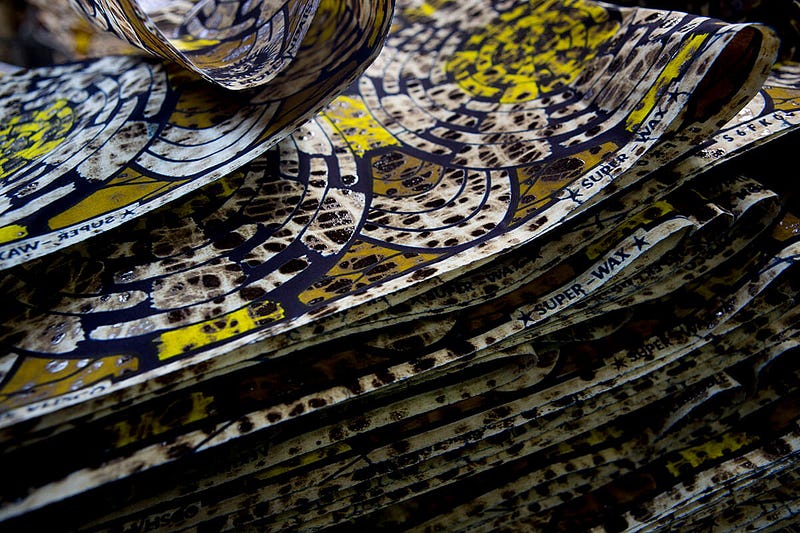Wax Hollandais: African prints with Heart and History
At Maakola, we make and create our custom-made pieces with designs and fabric steeped in meaning. One of our favorite textiles to use are African prints, specifically Wax Hollandais.


What is Wax Hollandais Fabric?
This vivid and charismatic wax print by Dutch fabric house Vlisco is renowned for its lively designs, beautifully saturated colors, and color intensity on both sides of the textile.
African Prints such as Hollandais are omnipresent in Africa, predominantly West Africa, and are used to make clothing and other textiles. The Vlisco fabrics, although made in the Netherlands, are named by West African traders and customers — something that gives these fabrics such a unique authenticity.
You can read more about how saleswomen turned Hollandais fabric into a cultural phenomenon through storytelling here.
Each fabric has a name that tells a story. The magic of Wax Hollandais prints is the way their designs were perceived as a way of communication. Through cultural storytelling, the fabric became so much more than just another textile.
Some key features of the fabric:
- Made with 100% cotton yarn
- Soft to the touch and comfortable against the skin
- Slightly weighty with a lovely drape
- Tightly woven making it durable and easy to care for
- Comes in a huge array of patterns, prints, and colors
- Ideal for all kinds of garments.
- Easy to care for


The History of the Fabric
The history of Wax Hollandais is as beautiful and intriguing as the fabric itself. The process of making the fabric is originally influenced by batik. This Indonesian (Javanese) method of dyeing cloth with melted wax techniques caught the eyes of Dutch merchants during the Dutch colonization of Indonesia in the 1850s.
Merchants took samples of the textile back with them to the Netherlands. It was here that owners of textile factories also fell in love with the fabrics. Using their printing methods, they were able to develop machine printing processes to replicate the original batik fabrics.
Although the imitation fabrics didn’t successfully penetrate the batik market, they did receive a strong reception in West Africa. These fabrics quickly became beloved and adopted the name Wax Hollandais or African Prints. The fabrics became a method of communication, thanks to their patterns, they became a kind of shared language. Designs were given unique names based on how customers perceived them.
By the mid-twentieth century, prints became more African-inspired and African-owned. Wax Hollandais became the fabric of choice for formal wear by diplomats and the elite.


Wax Hollandais Printing Process
Although the wax fabric is made using modern machinery, the process is remarkably complex. This is another reason why we love it so much. So how is wax print fabric made? Making the fabric is an art and one that is filled with craft and talent. Each piece of fabric takes an average of 27 steps. Here is a look at how the process works.
-
The Design
The process starts with Vlisco’s designers, who create the patterns using Vlisco’s exclusive colors. Vlisco’s use of vibrant shapes and deep, rich, saturated colors set its African Wax prints apart.
-
The Rollers
The design support team translates the designs into a digital format so that they can be engraved onto copper rollers. These rollers then apply melted wax to both sides of the fabric as it passes through.
-
The Indigo Bath
The first stage of the dyeing process is when the cloth is immersed in a bath of indigo dye. This color is renowned with Vlisco’s Wax Hollandais. Whatever part of the cloth is not covered by the wax is dyed a deep and beautiful blue.
-
Breaking the Wax
In the earliest days of wax print, the machinery caused small cracks in the wax that let the dye seep through. This created a bubble effect. What seemed like an imperfection at first, turned into something positive, as African customers loved this effect.
Vlisco decided to include the crackling effect with all wax fabrics, by breaking up random parts of the wax in a special machine. The resulting imperfections are what make each bolt of cloth unique and beloved by so many.
-
Applying the Color
The cloth is dried, and then the first layer of color is applied. The wax is removed before applying the second color over the top. It is this clever build-up of color that gives each design its vibrant palette. Sometimes, embellishment is added. Then the fabric is ready for a final wash to remove any remaining dye or wax.


The Maakola Meaning: How we Work with African Wax Print
At Maakola, we adore using this stunning fabric. Not just for its unique properties, but because of its rich history and deep meaning.
Thanks to its softness, weight, and handle, Wax Hollandais fabric makes the perfect textile for dresses, coats, skirts, tops, and more. The variation of designs and colors always makes it an exciting cloth to work with and wear.
You can shop our unique range of custom made clothing, made with Wax Hollandais here, and make yourself part of the fabric’s beautiful story.


Learn More About How Wax Prints Became a Cultural Phenomenon











